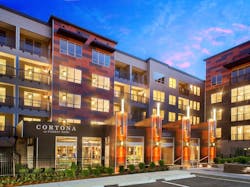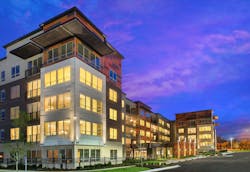Illumination Panels Provide Cost-Effective, Durable Option for Building Teams
For many building projects one would like to hear that money's no object. Unfortunately, tight budgets mean searching for materials and labor that won’t break the bank, but will still provide a long-lasting product.
Enter Nichiha Illumination panels. This line of fiber cement panels is being utilized in schools, healthcare, retail, and hospitality sectors—providing the built world with a high-quality, durable product that is accommodating for constrained budgets, and made with 20 percent post-consumer recycled content. In addition to its budget friendliness, the line is aesthetically pleasing and capable of matching to a broad spectrum of colors. The line of panels also carries a 50-year warranty.
“The virtue of the panels is the very clean, rigid appearance of them,” says Jonathan Brown, Senior Associate at JHP Architecture. “A lot of metal panels can warp, but these don’t.”
For one project, a mixed-use development in Duluth, Minn., that overlooks Lake Superior, DSGW Architects needed a thicker material for panels. Since the project was located six stories up and faced the lake, the architects had high wind loads to contend with. “That was a consideration for why we wanted the heavier panels,” says John Erickson, Principal of DSGW Architects.
The thicker product material of Illumination made it more durable than other panels. The firm considered using metal panels for a portion of the building when the schematic design was being mapped out. “We would have [had] to introduce a whole new system for the metal panels,” says Katherine Gerzina, Intern Architect at DSGW. “The Illumination panels gave us the look we [were hoping to achieve].
Nichiha panels utilize a hidden clip system for installation that doesn’t require special tools or labor. DSGW said this was another reason they choose the Illumination panels versus an alternative system, where they would have had to independently specify a mounting system.
Besides ease of installation, many experienced ease of use when ordering color samples through Nichiha’s Color Xpressions System. “I think it’s a pretty streamlined system,” says Michael Smith of Humphreys & Partners Architects, who worked on the Cortona at Forest Park project in St. Louis (pictured above, twice). “Getting samples was very easy—[we] just had to tell Nichiha a paint color to match from any manufacturer, and they color [matched] it and sent a 4-inch by 4-inch sample to confirm.”
Karen Quinn, an architect at The Boudreaux Group, echoes Smith’s sentiment. “We sent them paint colors that we wanted to match based on user input, and they provided us with a full spectrum of samples so that we could confirm uniformity,” Quinn says. “That was easy to do and the customer service was very responsive—samples did not take long to arrive.”
Quinn’s firm was also drawn to the cost effectiveness of the Illumination panels. “We looked at using metal panels on the building, and just due to our budget and constraints we looked for a [more accommodating cost solution] that would also convey that aesthetic without compromising the durability of the exterior,” she says.
Thanks to color matching capabilities, color options overall greatly increase for architects. Quinn now had the ability to tweak the Nichiha panels to match some of the exterior design elements, such as polycarbonate panels, that weren’t as flexible. “We picked up on cues from other materials that only had limited colors, and it was important to us that Nichiha panels were flexible,” Quinn says.
Illumination panels provide architects and builders the ability to respond to the unique needs of their communities while being cost-effective. Finished in a way that gives the appearance and depth of a metal panel, Illumination panels are heavier and a more durable option for builders, that won’t warp over time like metal panels.

